Lion850
National Hazard
   
Posts: 514
Registered: 7-10-2019
Location: Australia
Member Is Offline
Mood: Great
|
|
Taurine metal salts
In my ongoing search for interesting or unexpected colors I tried to make complexes of some metals with taurine (C2H7NO3S). The taurine was purchased
from eBay as food grade.
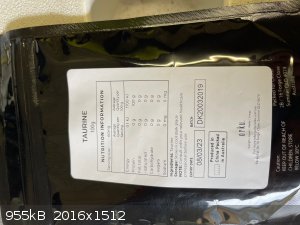
I could not find solubility info, but found that 3.5g taurine did not dissolve in 100ml cold water, but it did dissolve in 100ml water near boil. I
wanted to see if this hot taurine solution would react with transition metal carbonates direct, but there was no sign of any reaction with either
copper or cobalt carbonate. I then used sodium as an intermediate for all the following experiments.
Thus, sodium taurinate (C2H6NNaO3S) was first made and and this was then mixed with a metal salt solution. Whether the reactions were straight double
displacements or whether the products were metal-sodium taurinate complexes I have no idea; I found minimal info online.
Copper:
- 6.1g taurine and 3.2g NaOH was added to 100ml water. The solution quickly became almost completely clear at room temperature.
- 5.5g CuSO4.5H2O was dissolved in 80ml water, heated to get the blue solution completely clear.
- The hot copper solution was added to the sodium turinate solution.
- A suspension immediately formed that initially appeared blue-ish but as the reaction progressed it turned grey. This was the color after 30 minutes
of stirring.
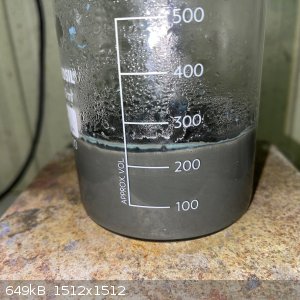
- Stirring was stopped and the reaction left overnight. The next morning there was a grey ppt with pale blue supernatant liquid. Thus, it seems not
all the copper sulfate was consumed.
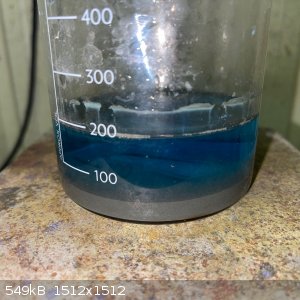
- The solution was gravity filtered. The ppt was quite fine and filtering took a while. The remainder washed in the funnel with water and then dried
on a steam bath. There was no sign of any decomposition on the steam bath.
- The result was 2.4g of dry grey product, which was found to be very easily soluble in dilute HCl.
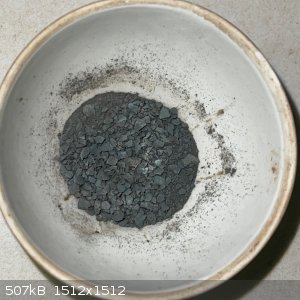
Not the color I was expecting, and I will soon be revisiting copper and do things slightly different.
|
|
|
Lion850
National Hazard
   
Posts: 514
Registered: 7-10-2019
Location: Australia
Member Is Offline
Mood: Great
|
|
Cobalt:
A similar procedure was followed as above, first make sodium taurinate and then add the cobalt sulfate solution.
- 6.9g taurine and 2.4g dissolved in 120ml water
- 7g cobalt sulpfate CuSO4.7H2O was dissolved in 100ml hot water, giving a red solution.
- The cobalt solution hot was poured into the hot taurinate solution while stirring. This was quite spectacular as the red cobalt liquid immediately
turned blue as it was poured into the sodium taurinate.
- The solution was stirred and the blue color quickly became a dark green. Stirring continued for one hour while the solution cooled. The final color
remained dark green.
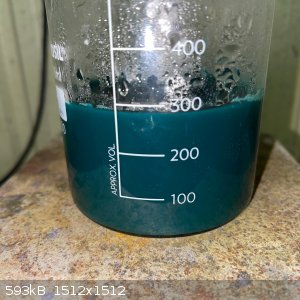
- The solution was left to settle and then gravity filtered. The filtrate was pale red which would indicate not all cobalt sulfate was consumed.
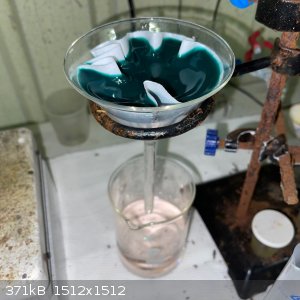
- The dark green remainder was dried on the steam bath for 2 hours; and then broken up. It was still slightly sticky.
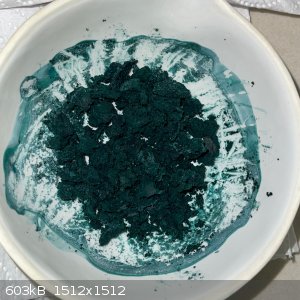
- A further 3 hours gave a hard dry product.
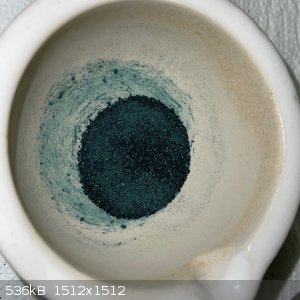
4.8g was recovered. The product is easily soluble in HCl. The green color was a nice surprise.
|
|
|
Bezaleel
Hazard to Others
  
Posts: 444
Registered: 28-2-2009
Member Is Offline
Mood: transitional
|
|
Hi, thanks again for posting your experiments. My experiments in the eighties had the same goal: searching for beautifully coloured precipitates or
compounds that are otherwise interesting. But back then I could not get any of the anions you play with. I actually didn't even know of their
existence.
It seems that you are short of taurine in both experiments. Could it be that your food grade taurine contains water? Did you try to add more sodium
taurinate to the blue and red filtrates, to see whether is is possible to precipitate all of your copper/cobalt?
BTW The cobalt compound might make a nice pigment for painting.
|
|
|
woelen
Super Administrator
        
Posts: 7976
Registered: 20-8-2005
Location: Netherlands
Member Is Offline
Mood: interested
|
|
The grey material you have may be impure copper(II) oxide. Copper(II) oxide is very dark grey, nearly black, and it easily dissolves in HCl, giving
cyan or green solutions, depending on the concentration of the HCl.
|
|
|
Lion850
National Hazard
   
Posts: 514
Registered: 7-10-2019
Location: Australia
Member Is Offline
Mood: Great
|
|
Bezaleel, Woelen, thanks for the input. I will have another go at copper using a different method and see what I get. I have also completed chromium,
manganese, iron, and nickel and will report soon.
|
|
|
Lion850
National Hazard
   
Posts: 514
Registered: 7-10-2019
Location: Australia
Member Is Offline
Mood: Great
|
|
Chromium:
- 10.2g Cr(NO3)3.9H2O was dissolved in 40ml water at room temp. This gave the usual very dark red-black solution.
- 9.7g taurine and 3.2g NaOH was dissolved in 100ml water, at room temperature.
- A very pale blue suspension immediately formed. This did not change in color after 15 minutes stirring. I then started heating the stirring solution
to boiling - as the temperature increased the color darkened steadily to green. There was also a tiny amount of bubbles, not sure if from a reaction
or just from the stirring. There was no smell. Below photos show the color shift.
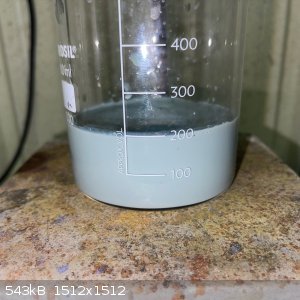 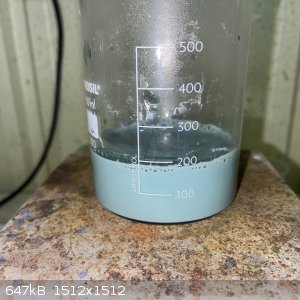 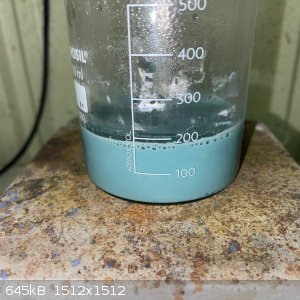 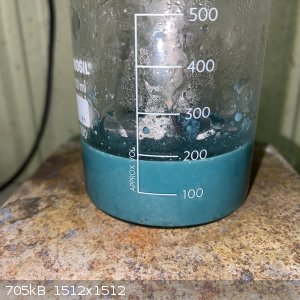 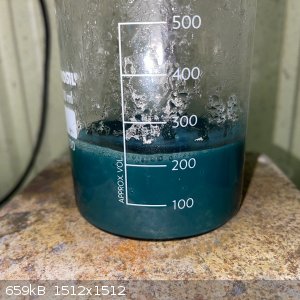
- The heat was turned off and the stirring maintained while the solution slowly returned to room temperature. The color stayed dark green. At this
point I wondered whether I ended up with Cr2O3.
- The solution was filtered. The filtrate was completely clear, with a dark green remainder.
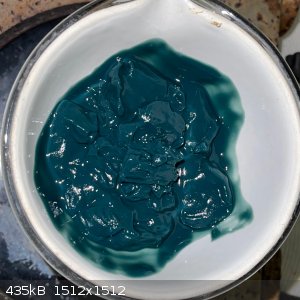
- The remainder was dried on the steam bath. After 2 hours it was still a bit sticky, and it was then dried for a further 3 hours. There was no sign
of decomposition.
- 7.9g of dry dark green powder was obtained.
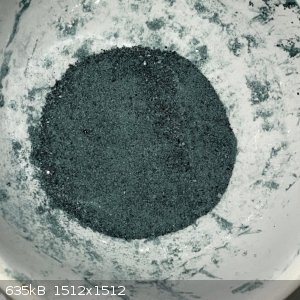
- The compound is slowly soluble in HCl.
This amount means that is not Cr2O3, or rather not only Cr2O3, but another green Cr compound. Chromium taurine is mentioned online but with no
description. If I use the equation below which regards the sodium stage as purely an intermediate and thus not part of the equation
Cr(NO3)3.9H2O + 3C2H7NO3S = Cr(C2H6NO3S)3 + 3HNO3 + 9H2O
and start with 10.2g chromium nitrate the expected yield of chromium taurinate should be 10.8g, which means I got 73%.
Maybe I should repeat the experiment, but not heat the solution, and if this yields a light blue product see how much I get.
Edit: I forgot that my chromium nitrate is very old and a bit wet. So the effective weight of the Cr(NO3).9H2O was surely less than the measured
10.2g. Which will of course contribute to a lower yield.
[Edited on 11-5-2022 by Lion850]
|
|
|
Lion850
National Hazard
   
Posts: 514
Registered: 7-10-2019
Location: Australia
Member Is Offline
Mood: Great
|
|
Manganese:
- 10g taurine and 3.3g NaOH dissolved in 120ml water without heating, almost completely clear solution.
- 10g MnSO4.xH2O dissolved in 120ml water, heated to obtain a clear pale pink solution
- Add manganese to taurine solution, both now hot.
- Cream colored suspension formed
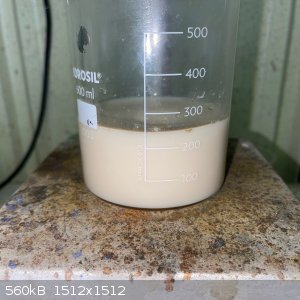
- After 2 hours stirring the solution turned light brown with darker brown where exposed to air.
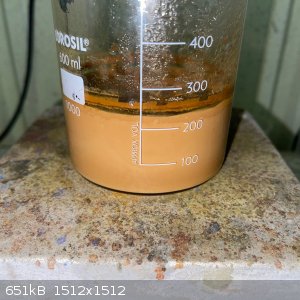
- Gravity filter. Easy to filter. Light brown filtrate, darker brown remainder (I saw the next day that the filtrate cleared up and more brown dust
settled, thus either the product is fine enough for some to pass through the filter or some stayed dissolved and fell out during the colder night).
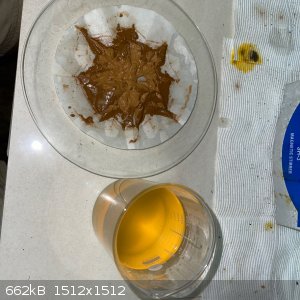
- On steam bath for 3 hours, this product dries quick.
- 3.5g of fine brown powder was recovered.
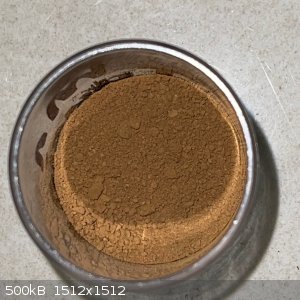
- When treated with HCl, product turns black and then dissolved slowly. No chlorine smell. A manganese taurine complex is mentioned online but whether
this is it I do not know.
|
|
|
Lion850
National Hazard
   
Posts: 514
Registered: 7-10-2019
Location: Australia
Member Is Offline
Mood: Great
|
|
Iron:
- 10g taurine and 3.3g NaOH dissolved in 120ml water
- 9.7g Fe(NO3)3.9H2O dissolved in 40ml water. Amber colored solution.
- Add Fe solution to taurine solution. A brown suspension immediately formed.
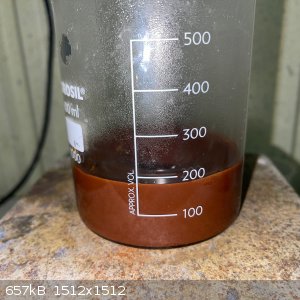
- Stir and heat to boiling, no change and no bubbles.
- Let cool slowly and gravity filter.
- The filtrate was completely clear and a dark brown remainder was recovered.
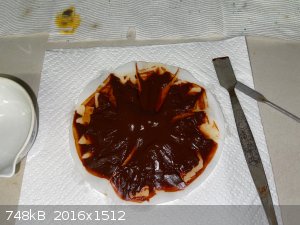
- Dry on steam bath for 3 hours. No sign of decomposition.
- 4.9g dark brown powder recovered. If this is indeed Fe(C2H6NO3S)3 then the yield was only about 50%.
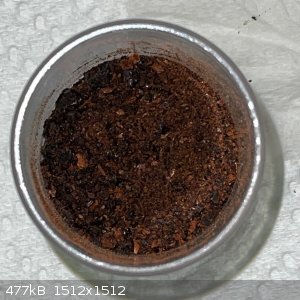
- The product dissolves readily in concentrated HCl, giving a yellow-ish solution.
|
|
|
Lion850
National Hazard
   
Posts: 514
Registered: 7-10-2019
Location: Australia
Member Is Offline
Mood: Great
|
|
Nickel:
Nickel turned out to be more interesting.
- 10g Taurine and 3.3g NaOH dissolved in 120ml water.
- 9g Ni(NO3)2.6H2O dissolved in 40ml water. Green solution.
- Add nickel to taurine with stirring, solutions at room temp.
- Solution quickly turned blue with minimal suspension, if any.
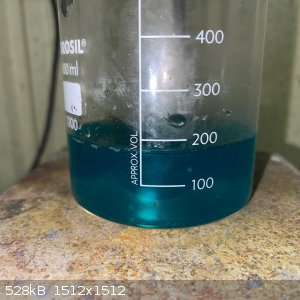
- Heat to boil while stirring. Pale green suspension formed at heat.
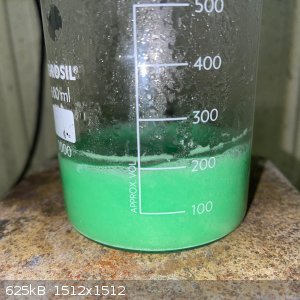
- Switch off heat and let cool slowly on hot plate while stirring. Switch off stirring once cool. A pale green ppt settled with blue supernatant
liquid.
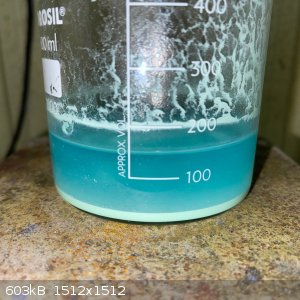
- Gravity filter. Blue filtrate, pale green remainder.
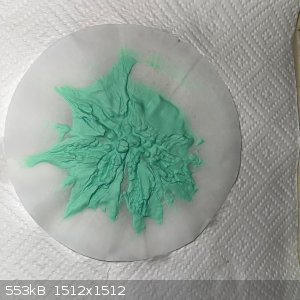
- Dry remainder on steam bath for 4 hours. Obtained 3g of dry light green powder.
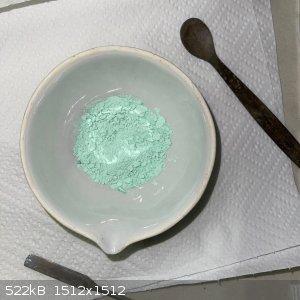
- Steam down blue remainder to 20ml - color intensified as volume decreased but no crystals forming. Switch off the heat when it became syrupy.
- Next morning found a mass of wet blue crystals. Put on steam bath.
- Melts to a liquid at steam bath heat but does not seem to lose any more water. Stop steam bath after 2 hours.
- Place in desiccator while still hot (on a bed of NaOH) and such vacuum. A few bubbles appeared under vacuum but not much. Leave in desiccator for 48
hours, vacuum was maintained.
- Much drier after 48 hr in the desiccator but still damp.
- 15.2g of damp sky blue product recovered.
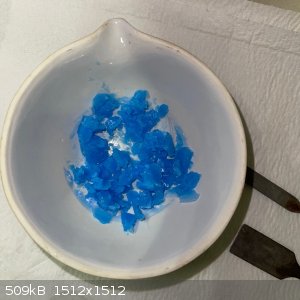
I am not sure what happened here. Maybe nickel, sodium, and taurine formed mainly a soluble blue product that then partially decomposed to the green
product upon boiling. More questions than answers.
Below is the taurine family photo. Next I will revisit copper.
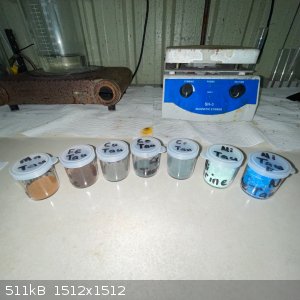
|
|
|
woelen
Super Administrator
        
Posts: 7976
Registered: 20-8-2005
Location: Netherlands
Member Is Offline
Mood: interested
|
|
The pale green material you get from nickel(II) most likely is nickel hydroxide.
What I think is that on mixing the nickel(II) salt with the alkaline taurinate solution, you get a blue complex, probably in excess alkaline taurinate
solution. On heating part of the blue complex seems to hydrolyze to nickel hydroxide (pale green solid) and in the resulting less alkaline solution
quite some blue taurinate complex remains. So, I expect that the pale green solid is fairly pure nickel(II) hydroxide and that the blue material is
impure nickel(II) taurinate, with excess taurine and probably some sodium taurinate in it as well.
This observation nicely augments your first observation with copper, which lead to a dark grey precipitate, which most likely is copper(II) oxide
(which in turn is formed from copper(II) hydroxide in boiling hot water).
|
|
|
Lion850
National Hazard
   
Posts: 514
Registered: 7-10-2019
Location: Australia
Member Is Offline
Mood: Great
|
|
Copper attempt #2
I decided to try to react copper powder direct with a taurine solution. To be honest I thought it was unlikely to do anything because as I mentioned
above a taurine solution did not show any sign of behaving like an acid with copper carbonate. I based my stoichiometry on the below equation with a
tiny copper excess:
2C2H7NO3S + Cu = Cu(C2H6NO3S)2 + H2
- 3.1g fine copper powder and 12g taurine added in beaker with 150ml water and stirred at room temperature. Below shows the initial solution:
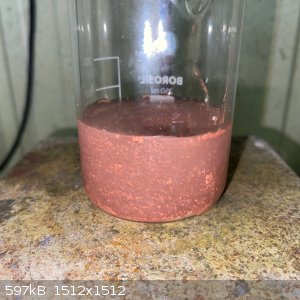
- After only 3 hours I notices some blue splashes on the sides of the beaker, I was surprised to see signs of a reaction so "quick".
- Stirring continued for days. The color of the reaction steadily changed. Every 12 hour or so I stopped stirring for 10 minutes to look at what
settled out. The free copper steadily decreased and a pale ppt steadily increased. Below photos shows the progression.
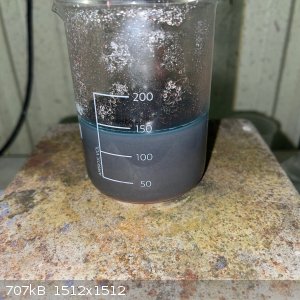
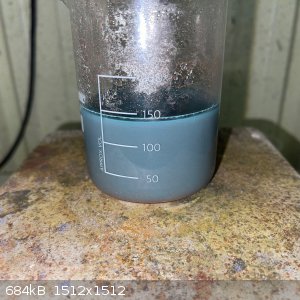
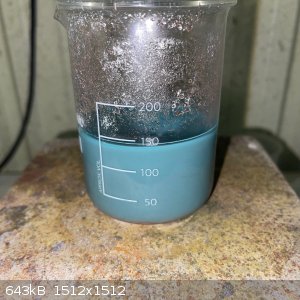
- After 95 hours the stir bar was turning without any scraping noise telling me most of the copper powder was gone. Looking through the bottom of the
beaker there was still some free copper smudges. Another 10 hours of stirring did not produce any further changes and stirring was stopped.
- At this point there was a grey layer on the glass, I realized later this was probably the product starting to decompose. Below the final appearance
after 105hr stirring.
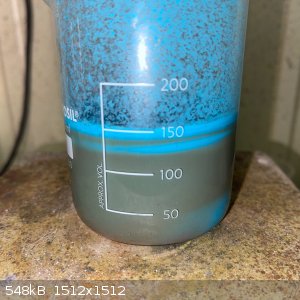
- The solution was filtered. There was a lovely blue colored remainder, a paste but not particularly sticky. The filtrate was also blue, probably
showing the product is slightly soluble in water.
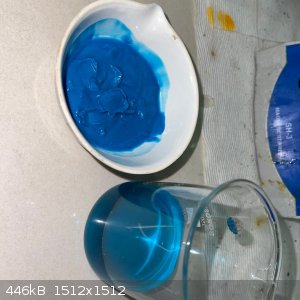
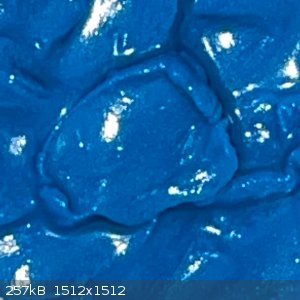
- I was hoping the product would dry on the bench but after 2 days the weight hardly dropped. I then put the evaporating dish on the steam
bath.....but when I returned only some 20 minutes later most turned into a thick dark brown sludge. And there was now a very faint smell, but not of
anything familiar, maybe very slightly sweet.
- And then when I used the long nose pliers to take the dish of the steam bath I dropped it and this was the result.....
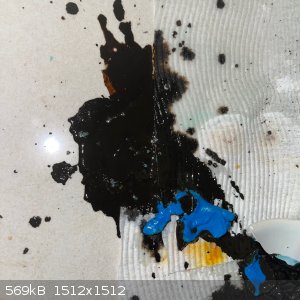
Even though the product was lost it was still interesting in that it showed taurine reacts happily with copper powder at room temperature. I could not
see any hydrogen gas production (or any other gas) but with fast stirring and a very slow reaction it may not have been easily noticeable.
I'm in 2 minds whether to repeat this. While it would have been nice to get some dry product and know the final yield I don't know whether it can last
long, seems to decompose fast at quite low temperature (around 60?). If I do it again I could try to dry it in the desiccator, or maybe see if alcohol
will dry it.
|
|
|
woelen
Super Administrator
        
Posts: 7976
Registered: 20-8-2005
Location: Netherlands
Member Is Offline
Mood: interested
|
|
I do not think that taurine itself oxidizes copper, but oxygen from the air most likely is the oxidizer. Finely divided copper can fairly easily be
oxidized by oxygen from air if a suitable coordinating agent is present as well. This is simply demonstrated by adding copper powder to ammonia and
bubbling air through it. The liquid turns blue fairly quickly (within a few tens of minutes). Another demo is adding copper to hydrochloric acid and
keeping this in contact with air. The liquid turns green/brown quickly. In your experiment, I expect the taurine or one of its anions to be the
coordinating agent.
|
|
|
Lion850
National Hazard
   
Posts: 514
Registered: 7-10-2019
Location: Australia
Member Is Offline
Mood: Great
|
|
Thanks Woelen. Now you have me interested to see what else amongst the stuff I have I can stir copper powder with. Thiourea comes to mind....
|
|
|
DraconicAcid
International Hazard
    
Posts: 4278
Registered: 1-2-2013
Location: The tiniest college campus ever....
Member Is Offline
Mood: Semi-victorious.
|
|
I found this paper about taurinates:
https://journals.iucr.org/e/issues/2011/10/00/bx2374/bx2374....
I can't do the high-pressure synthesis, but once I get some taurine, I'll see what I can do.
Please remember: "Filtrate" is not a verb.
Write up your lab reports the way your instructor wants them, not the way your ex-instructor wants them.
|
|
|
KoiosPhoebus
Hazard to Self
 
Posts: 51
Registered: 23-1-2023
Member Is Offline
|
|
Quote: Originally posted by Lion850  | Manganese:
- 10g taurine and 3.3g NaOH dissolved in 120ml water without heating, almost completely clear solution.
- 10g MnSO4.xH2O dissolved in 120ml water, heated to obtain a clear pale pink solution
- Add manganese to taurine solution, both now hot.
- Cream colored suspension formed
- After 2 hours stirring the solution turned light brown with darker brown where exposed to air.
- Gravity filter. Easy to filter. Light brown filtrate, darker brown remainder (I saw the next day that the filtrate cleared up and more brown dust
settled, thus either the product is fine enough for some to pass through the filter or some stayed dissolved and fell out during the colder night).
- On steam bath for 3 hours, this product dries quick.
- 3.5g of fine brown powder was recovered.
- When treated with HCl, product turns black and then dissolved slowly. No chlorine smell. A manganese taurine complex is mentioned online but whether
this is it I do not know.
|
I would guess that this is some kind of manganese(III) complex, as Mn(II) complexes
of amino acids are typically yellow, and Mn(II) complexes of aminopolycarboxylic acids are dark red. The browning towards the top where it is exposed
to air is also suggestive of oxidation. Mn(II) hydrolyses very readily in basic solutions to give various manganese(II) hydroxides, which oxidise to
the +3 oxidation state. Mn(III) is usually unstable in solution but can be stabilised by complexation.
The best way I've found to prepare Mn(II) complexes of a chelating basic anion (like taurinate or glycinate) would be to use manganese(II) acetate.
This publication uses that method to prepare manganese(II) ethylmaltolate: https://doi.org/10.1016/j.ica.2005.09.025.
If there exists a salt of taurine which is soluble in a specific organic solvent, then the next best option is to conduct the reaction in that
solvent. e.g.:
LiOH + TauH → LiTau + H2O
MnCl2 + 2 Li(Tau) → Mn(Tau)2 + 2 LiCl
In the above example, manganese(II) taurinate would precipitate from the solvent, while lithium chloride remains dissolved. As long as the
manganese(II) taurinate is air-stable, you should be able to filter it off and leave it to dry. If you use lithium hydroxide as your base, a
reasonably wide range of manganese salts can be used (chloride, nitrate, acetate) in a pretty wide range of organic solvents.
If no organic-solvent-soluble salt of taurine can be obtained, the next best option is to prepare the lithium taurinate in the minimum amount of
water, add that to an alcohol solution of the manganese salt, and filter off the precipitated manganese(II) taurinate as quickly as possible. Washing
with the alcohol (I use ethanol) may help to remove any oxidised metal complex - my experience is that the higher oxidation states tend to dissolve
more readily into ethanol. This is how I initially isolated ferrous cysteinate (Fe(CysH)2 - CysH as the amino group is protonated; the
thiol and carboxyl groups are more acidic and hence deprotonate first). With the above procedure, ferrous cysteinate precipitated out of solution as a
pale-yellow solid but ferric-cysteine formed a purple complex where the solvent remained in contact with air, remaining dissolved in the ethanol-water mixture:
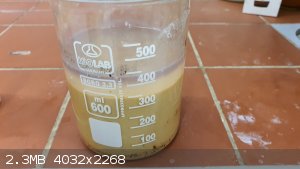
(unfortunately, ferrous cysteinate is very readily oxidised by air, so I was unable to obtain it dry without oxidation)
Finally, there is always the option of preparing an adduct complex instead of a chelate. In this case, you would be simply adding the metal salt to
the chelator e.g.:
MnSO4 + 2 TauH → Mn(TauH)2SO4
Based on the pKa of the sulphonate and amino groups, the manganese would probably be complexed through the sulphonate groups with the amino groups
remaining protonated and hence not coordinating to the manganese. This probably results in a different colour from a chelate where all complexing
groups are coordinated to the metal. Typically I find that this is approximately in between the colour of the metal-aquo complex and that of the
chelate, however sometimes you get interesting colour shifts as different groups become involved in complexation. For example, in this picture:
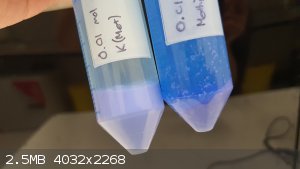
0.005 mol copper(II) sulphate was reacted with 0.01 mol of either potassium L-methioninate (KMet, on left) or 0.01 mol of L-methionine (MetH, on
right). In comparison to the copper(II)-aquo complex, the Cu(II) + L-MetH solution is a darker blue (unfortunately I did not get a picture of the
copper(II) solution prior to adding methionine). But the reaction between CuSO4 and KMet produces a light, lilac precipitate. My guess is
that Met- forms a much stronger chelate than MetH, allowing for some coordination of the thioether group to copper ions.
Hope some of this was helpful! Working with the easily-oxidisable transition metal ions can be frustrating especially if you're working in alkaline
conditions.
|
|
|
Quieraña
Harmless

Posts: 34
Registered: 24-8-2019
Member Is Offline
|
|
This was awesome. I've been impressed with complexes of the transition metals ever since I learned about nickel hydrazine nitrate, the way the color
went pink like that. I enjoyed the fact that copper actually created a bland gray like that versus how it usually reacts. It made me wonder about zinc
or magnesium, given those usually don't put up much color. I apologize that I cannot put any pictures at this time of anything you all could
appreciate. In time though I intend to give you a show. Cheers
|
|
|
DraconicAcid
International Hazard
    
Posts: 4278
Registered: 1-2-2013
Location: The tiniest college campus ever....
Member Is Offline
Mood: Semi-victorious.
|
|
My taurine just arrived, so I'll be able to try some of these soon.
Please remember: "Filtrate" is not a verb.
Write up your lab reports the way your instructor wants them, not the way your ex-instructor wants them.
|
|
|
KoiosPhoebus
Hazard to Self
 
Posts: 51
Registered: 23-1-2023
Member Is Offline
|
|
Attempts at preparing Mn(II)-taurinate
I tried my hand at preparing manganese(II) taurinate through several methods.
Reacting manganese chloride with lithium taurinate
This involves dissolving manganese chloride in ethanol, then dissolving two molar equivalents of lithium hydroxide and taurine in a separate solution
of ethanol. Unfortunately, the lithium hydroxide/taurine did not readily dissolve, so I had to add water until the solution was about 2:1
ethanol/water for everything to dissolve.
When the lithium taurinate solution was added to manganese chloride, a pale yellow precipitate was rapidly formed. After filtering off the precipitate
and washing it with ethanol, it became brown, which suggested likely oxidation upon exposure to the atmosphere and formation of either a basic Mn(III)
complex or Mn(III)-oxyhydroxide.
Reacting manganese acetate with taurine
My guess is that the manganese taurinate complex is being hydrolysed in solution, forming Mn(OH)2, and oxidising. I found a paper about
attempting a solvent-free synthesis which sounded quite promising (https://www.idosi.org/wasj/wasj14(2)11/5.pdf).
To perform this synthesis, I grinded 1.23 g of manganese(II) acetate tetrahydrate (0.005 mol) with 1.26 g of taurine (0.01 mol). Similar to that
publication, after a brief period of time, the smell of acetic acid started to emerge from the mixture. I didn't smell any acetic acid when I checked
in on it after a couple of hours, but after gently heating the mortar, a small amount of acetic acid was observed, so I left it on the hotplate for a
couple of hours.
After that time, I didn't smell any acetic acid, so I brushed the pink powder into a separate vessel to weigh it.
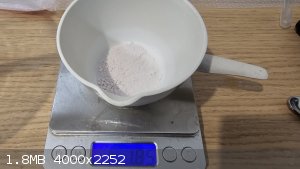
Acetic acid has a molar mass of 60.052 g/mol, so, assuming no loss of the waters of crystallisation, we'd expect the mixture to lose 0.6 g of mass.
1.85 g is reasonably close (expected: 2.49 g - 0.6 g = 1.89 g) with the difference probably due to a combination of scale inaccuracy and minor loss
of water of crystallisation.
I dissolved a small sample of the manganese taurinate, and obtained a dark-pink solution with a pH = 6.8. This suggests to me that there was likely
some acetic acid remaining in the mixture, as manganese taurinate should be slightly basic. It's plausible that this was also the case with the
copper(II)-cysteinate publication (their C% and H% was higher than theoretical), but another possibility is that the manganese(II)-taurinate complex
is weaker than the copper(II)-cysteinate complex and therefore it's more difficult for the reaction to proceed to completion.
However, after heating the solution for a few minutes and concentrating the solution down by about 50%, the pH increased to ~7.2. Further heating
produced a slightly dark-pink-white powder:
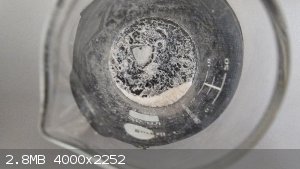
Unfortunately, when I tried recrystallising the remaining manganese(II) taurinate by the same method, the solution turned brown and a dark-brown
precipitate formed, suggesting oxidation to Mn(III) and precipitation as Mn(III)-oxyhydroxide or basic Mn(III)-taurinate. I have no idea how this
happened when it didn't with the smaller sample (or maybe the initial sample did oxidise but it was so diluted that it wasn't readily observed?).
The manganese(II) taurinate prior to recrystallisation:
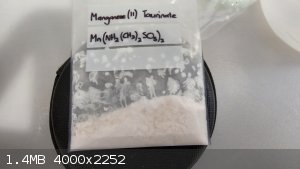
Based on the mass, my guess is that this is somewhere between a trihydrate and a tetrahydrate, with some contaminating acetic acid/acetate.
|
|
|